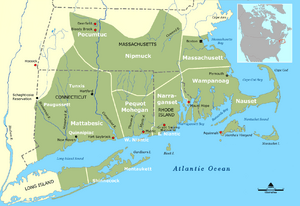Ninnimissinuok facts for kids
The Ninnimissinuok are Native American people from the southern New England area. This group includes tribes like the Pawtucket, Massachusett, Nipmuck, Pokanoket, Niantic, Mohegan, and Pequot. It also includes people from western Connecticut and Long Island. The word Ninnimissinuok comes from the Narragansett language and means "people." It shows a feeling of being connected and sharing a common identity.
Even though they shared a name, the Ninnimissinuok people were not all the same. Southern New England had many different communities. These groups sometimes formed larger political units. They lived in at least three main types of natural areas: the coastal regions, along rivers, and in the uplands. While they shared similar beliefs, languages, and a long history, each group developed unique ways of life and economies based on their environment.
Daily Life and Food
The Ninnimissinuok people often moved their homes depending on the season. Their houses were made from flexible branches bent into a circle. These were covered with mats made of reeds, hemp, and animal hides. There was a hole in the roof for smoke from a central fire.
Each tribe moved twice a year. They went from warmer forested areas in winter to summer homes near their cornfields. Corn and other grown vegetables were a very important part of their diet. One early report from 1634 noted that they ate a lot, but not much meat. Studies suggest that about 60% of their daily food came from grains. Only about 10% came from animal or bird meat.
Men cleared fields for farming. They also prepared the ground and used fish and shellfish to make the soil fertile. Women took care of weeding the crops using hoes made from clam shells. The English settlers were very impressed by how carefully the women tended their gardens.
Leaders and Their Role
Leaders among the Ninnimissinuok were called sachems. They were chosen from a family group, possibly through the mother's side of the family. The area ruled by a sachem was known as a sontimooonk or sachemship. People in a sachemship promised to protect their sachem and the idea of leadership itself.
Sometimes, one sachem might rule over many other sachems. English writers called these powerful leaders "kings" or kaeasonimoog. Sachems had control over specific areas of land. These areas were often marked by natural features like rivers or mountains.
A sachem's power was strong within his territory. However, it was traditional for sachems to try and get everyone to agree on important decisions. If someone did not like their sachem, they could often choose to leave and live under a different, more agreeable leader. This helped prevent sachems from becoming too strict.
First Encounters with Europeans
For almost 100 years before the Mayflower arrived in 1620, the Ninnimissinuok had some contact with European explorers. Even before that, they felt the effects of European cod fishermen working off the Newfoundland banks. These early meetings had a big impact.
First, Europeans brought many diseases. The Native people had no protection against these illnesses. When English settlers arrived, they found huge areas of southern New England empty. These lands had been cleared for farming and settlement, but now no one lived there.
Second, the "Fur Trade" changed the Native economy. At first, Newfoundland fishermen traded furs. Later, the French and English traded more regularly. Before this, Native groups traded local products peacefully across the continent. The new fur trade focused on animal pelts, which Europeans wanted. This led to more competition and fighting between Native tribes. The English sometimes used these rivalries to their advantage.
The English also caused problems with their aggressive approach to settling the land. This caused bad feelings and eventually led to conflicts. The English system relied on private individuals trying to make money. An English writer named Richard Hakluyt wrote in 1585 about the goals of these early explorers: to spread Christianity, to trade, and to conquer. The goal of spreading Christianity was not seriously pursued.


